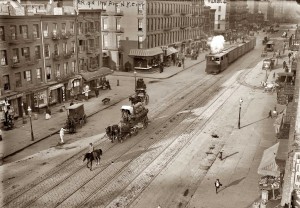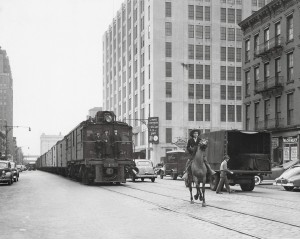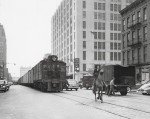Since the 1999 establishment of Friends of the High Line made the park an international cause célèbre, the story of the “West Side Cowboy” has become embedded in the High Line’s narrative. [For the full, updated story of the West Side Cowboy’s final ride, including some rare photos, click here.]
Photographs of the cowboy show him in various states of attire, from a formal uniform at the turn of the century (as at left) and later in jeans and felt hat (below). Video, however, is exceedingly rare. I discovered the footage here while researching my book, and organized it into a short narrative with musical accompaniment. The footage was taken in the 1930s and shows a New York Central locomotive steaming down Tenth Avenue, past the High Line — then a working railroad — preceded by the now-famous man on horseback. The footage is scrappy, but you can see many wonderful details, including (at the beginning) a glimpse of a large luxury liner in the harbor. This video shows, in a way that still photographs simply can’t, what it was like when freight trains ran at grade down the streets of Manhattan’s West Side.
The job of urban cowboy was created by an 1850s city ordinance that permitted freight cars to run along the streets so long as they didn’t exceed six miles per hour and that the railroad — first the Hudson River, later the New York Central — “shall employ a proper person to precede the trains on horseback, to give the necessary warning in a suitable manner on their approach.” Still, so many accidents and deaths occurred that Tenth Avenue came to be known as “Death Avenue.”
The “proper persons” were the West Side — or Tenth Avenue — Cowboys; they waved a red flag by day and a red lantern by night to give their necessary warning. New York’s urban cowboy figured in Mario Puzo’s 1965 novel, The Fortunate Pilgrim, in which the young men were known as “dummy boys.” A scene in the novel, which is set in the Hell’s Kitchen neighborhood where Puzo grew up, describes two boys gazing out their childhood window: “Far down Tenth Avenue they could see the red lantern of a dummy boy and behind it, like a small round ghost, the white dot of the trailing engine searchlight.”
It was at 10:50 a.m., not high noon, that the last cowboy rode down Tenth Avenue. It was March 29, 1941. He was George Hayde, age twenty-one, mounted on what one reporter dubbed “his faithful bay, Cyclone.” The two led a string of fourteen freight cars loaded with oranges. A team of reporters who covered the event agreed afterward that George and Cyclone completed the trip without exceeding the speed limit. Click here to read about the newly discovered photographic history of George and Cyclone’s final ride.
Click here to read a longer excerpt from The Fortunate Pilgrim and a description of the horses and their “gallant riders” in a 1933 edition of the London Terrace Tatler.
Click here to read the blog post “The West Side Cowboy & The High Line: A Birthday Tribute.”
“The West Side Cowboy and the High Line,” edited by Annik La Farge. Piano accompaniment: opening section of Franz Schubert’s “Moments musicaux,” Opus 94, No. 2, played by Rafael Cortés











A tidbit of NY history I knew nothing about! Thank you!
The ship’s funnel colors are those of the United States Line. In all likelihood, the ship is either the SS Manhattan, entered service 1932, or her sister ship SS Washington, which entered service in 1933.
Thank you for an eloquently told remembrance from a living history book, and for an historic video that seems so incredible today.
Great part of NYC history 10th Ave cowboy
Love those pictures & the film Thanks!
Thank you so much Annik La Farge for a wonderful job, putting together this great history on the Highline and sharing this with others. You are the best!
Thank you, Randy. Couldn’t have done this one without you.
Thank You Annik, New York Central’s Railroad History and the book beautifully done.
[…] Aerial view of “Death Avenue” and the cowboy accompanying carriages as well as the train image via livinthehighline.com […]